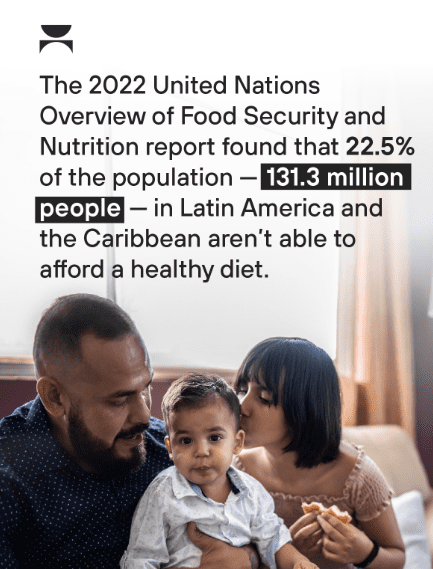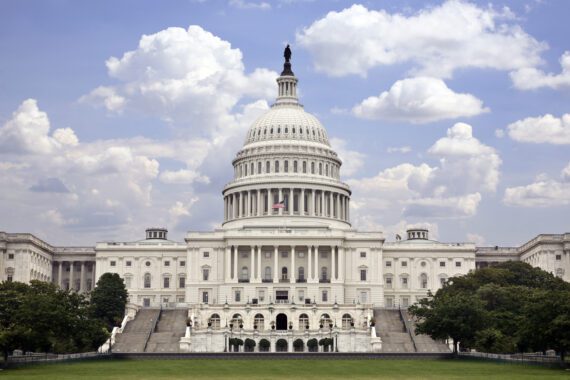Latinos(as) make up a large, diverse community that plays an important role in American society and throughout the world. Not only are Latinos(as) the fastest growing part of the American electorate but they contribute greatly to the economy, with a gross domestic product (GDP) in the U.S. totaling an incredible $2.8 trillion — greater than the national GDP of India, Italy, the United Kingdom, and France.

Unfortunately, despite such notable contributions, Latinos(as) are often among the demographics most impacted by hunger and food insecurity. It’s estimated that around 16% of Latino(a) households in the U.S. are experiencing food insecurity – an ongoing uncertainty of where their next meal will come from. And the 2022 United Nations Overview of Food Security and Nutrition report found that 22.5 percent of the population — 131.3 million people — in Latin America and the Caribbean aren’t able to afford a healthy diet, 8 million more people than in 2019.
It’s imperative that our nation’s leaders commit to addressing disproportionate hunger rates in Latino(a) communities and among all people. At Bread for the World, we recognize there are a number of factors that contribute to these concerning rates, including conflict, climate change, wage gaps, racial discrimination, along with other socioeconomic inequities. In this article, we’ll explore the current state of hunger and answer questions such as:
- How many Latinos(as) in the U.S. experience hunger?
- Why are Latino(a) communities experiencing hunger at disproportionate rates?
- What is the hunger rate in Latin America and the Caribbean?
- How can we address hunger in Latino(a) communities?
This Hispanic Heritage Month is a great time to commit to addressing the problem of food insecurity affecting Latino(a) families through advocacy, policies, and programs that ensure all people can access the nutritious food they need to thrive.
How many Latinos(as) in the U.S. experience hunger?
In the U.S., hunger rates among Latino(a) communities have been increasing at concerning rates, particularly amid and in the wake of the COVID-19 pandemic. The national Latino(a) population totaled 62.5 million in 2021, representing 19% of the U.S. population. And according to the U.S. Department of Agriculture’s (USDA) most recent Household Food Security report, 16% of Latino(a) households in the U.S. experienced hunger in 2021 — a decrease from 17% in 2020 yet still reflecting a need for greater efforts to increase food security among Hispanic households.
In the U.S., the measure of hunger is food insecurity — an ongoing uncertainty of where a person’s next meal will come from or lack of access to enough nutritious food to live a healthy life. This can be a temporary circumstance or can last a long time.
In 2021, an estimated 33.8 million Americans struggled to put food on the table. And while Latino(a) communities in the U.S. are a diverse demographic, rich in unique cultures and spanning socioeconomic realities, overall, a significant portion of Latino(a) households grapple with food insecurity. In fact, the USDA notes that Latinos(as) have consistently faced higher rates of food insecurity compared to the national average. During the COVID-19 pandemic in particular, rates of food insecurity were “substantially higher” than the national average for single-parent households along with Hispanic and Black households. The USDA also found that hunger was more common in rural areas and large cities than in suburban areas.
UnidosUS, the nation’s largest Latino(a) civil rights and advocacy organization, released a 2022 report examining hunger and food insecurity among Latinos(as) living in rural communities. It suggests that rural Latino(a) communities’ geographic locations “create barriers to accessing healthy foods and perpetuate a cycle of food insecurity” despite working on farms that grow much of the nation’s food in many cases.
It’s essential that our nation’s leaders prioritize policies and programs that can address hunger in Latino(a) communities. For example, nutrition programs, such as the Special Supplemental Nutrition Program for Women, Infants, and Children (WIC) and the National School Lunch Program (NSLP) are critical to meet the nutritional needs of Latino(a) children. Over 40 percent of WIC participants are Latino(a), and they make up close to a fourth of children participating in NSLP as well.
Root Causes of Hunger Among Latino(a) Communities in the United States
Socioeconomic disparities, including wage gaps, racial discrimination, educational inequities, and a range of systemic barriers, have played a role in fueling disproportionate hunger rates among Latino(a) communities in the U.S. The COVID-19 pandemic has exacerbated these vulnerabilities, increasing food insecurity often due to limited economic and social safety nets. Though far from an exhaustive list, a few key factors contributing to the high rates of hunger include:
- Economic Disparities: Economic inequality plays a substantial role in perpetuating hunger within Latino(a) communities. Latino(a) families who are working in low-wage jobs with limited benefits, making it challenging to afford nutritious food consistently. Despite having higher employment rates than non-Hispanic people and contributing significantly to the economy, many Latinos(as) in the U.S. are experiencing wage gaps that can stifle their financial security. While the statistics vary across Hispanic ethnic groups, overall Latino(a) workers in the U.S. encounter “persistent and pervasive ethnic wage gaps” compared with white, non-Hispanic men. Latina women are especially impacted by these disparities due to a variety of factors, namely the combination of sexism and racial discrimination.
- Immigration Status: Immigration status can significantly impact an individual’s or family’s access to resources. Families with undocumented family members may be hesitant to seek public assistance programs, often for fear that the undocumented member(s) may be discovered and face deportation. A 2021 report from the Urban Institute found nearly half of adults in mixed-status families — where one or more members are undocumented while the others are U.S. citizens or hold lawful immigration status — reported food insecurity. This estimate includes mixed-status Latino(a) families and similar families of other ethnicities, too.
- Language and Cultural Barriers: Some Latino(a) individuals and families face language and cultural barriers that make it difficult to navigate government assistance programs and other social environments. The Public Health Nutrition Journal released a study in May 2023 that examined the association between language use and food insecurity among Latino(a) adults in the U.S. between 1999–2018. The research found that Hispanic adults born outside of the country who “speak predominantly Spanish, or English and Spanish equally, have higher odds of food insecurity.”
- Food Deserts: Around 15% of Latinos(as) in the U.S. live in lower-income communities where the nearest supermarkets can be up to 10 miles away compared with 11% of non-Latino(a) whites. The lack of access to affordable and nutritious food outlets in certain neighborhoods, often referred to as food deserts, can contribute to poor or malnutrition. This is often the case in both urban and rural low-income areas.
- Unaffordable Housing: Despite increasing homeownership rates among Latinos(as) in the U.S., access and affordability remain a challenge, causing an unfortunate ripple effect on food security. In 2019, an estimated 21.2 million Latinos(as) (42%) lived in areas that lacked affordable housing. Stressors from a tight, expensive housing market can not only make home ownership difficult but force families to choose between buying enough nutritious food or keeping up with housing costs.
The issue of hunger in Latino(a) communities is complex and deeply entrenched, stemming from a long history of economic, social, racial, and cultural factors. Addressing this challenge requires a concerted effort involving effective policies, community engagement, and innovative solutions. By acknowledging the unique needs and circumstances of Latino(a) communities, and by empowering individuals with the tools to overcome barriers, we can pave the way toward a more nourished and resilient future for all. The question is not just how can we end hunger but do we have the political will to make it happen.
What is the hunger rate in Latin America and the Caribbean?
Hunger remains a critical issue affecting millions of people across the globe, and Latin America and the Caribbean are no exception. Despite making some progress over the last several decades, the region still grapples with high rates of food insecurity, malnutrition, and unequal access to nutritious meals. In 2021, 40.6 percent of the regional population experienced moderate to severe levels of food insecurity, compared to 29.3 percent of people worldwide.
Severe food insecurity was also more frequent in the region (14.2 percent) than in the rest of the world (11.7 percent). And between 2019 and 2021, hunger reached a “prevalence of 7.9 percent in South America, 8.4 percent in Mesoamerica, and 16.4 percent in the Caribbean.” Hunger in Central America — specifically in El Salvador, Honduras, and Guatemala — has been rising steadily over the past several years due to extreme poverty, political instability, and the impact of climate change. The COVID-19 pandemic has only exacerbated these issues, and chronic malnutrition rates within local Indigenous communities are among the highest in the world.
Unfortunately, children under five and women are among the most affected population groups as well. According to the UN, “nutrition-sensitive social protection programs are essential” to support the healthy diet and adequate nutrition of the most vulnerable populations.
Factors Contributing to Hunger in Latin America and the Caribbean
Several factors contribute to the persistent issue of hunger in the Latin American and Caribbean region, including:
- Climate Change: The region is highly vulnerable to the effects of climate change, including extreme weather events that disrupt agricultural production and livelihoods.
- Conflict and Political Instability: Instances of conflict and political instability can disrupt food supply chains and exacerbate existing inequalities.
- Income Inequality: High levels of income inequality often translate into unequal access to food. Vulnerable groups, such as indigenous communities and rural populations, can be particularly affected.
- Rural-Urban Disparities: A significant proportion of the population depends on agriculture for their livelihoods. However, limited access to resources, modern agricultural practices, and markets hinder the sector’s potential to alleviate hunger.
- Poor Infrastructure: Inadequate infrastructure, including transportation and storage facilities, can lead to food wastage and hinder the efficient distribution of food.
Hunger has far-reaching consequences that extend beyond mere physical discomfort. Malnutrition, especially among children, can have irreversible developmental effects, stunting both physical and cognitive growth. This perpetuates the cycle of poverty and limits future opportunities. Additionally, hunger weakens the immune system, making individuals more susceptible to diseases, and hampers overall productivity, which ultimately impacts economic development on a national scale.
U.S. aid plays an important role in providing humanitarian assistance in response to ongoing worldwide crises, from conflicts to natural disasters — all of which can contribute to relieving consequential increases in hunger. Congress should prioritize reauthorizing and expanding a 2023 farm bill, legislation that impacts not only national nutrition programs but foreign assistance. Moreover, the U.S. can work alongside regional governments, non-governmental organizations (NGOs), and international institutions to collectively address hunger in Latin America and the Caribbean. This could involve improving social safety nets, agricultural innovation, nutrition education, and climate resilience throughout the region. Hunger is solvable, and there’s already enough food to provide enough nutritious food for people around the world. Through concerted, holistic efforts, we can soon achieve a future where hunger is a thing of the past.
How can we address hunger in Latino(a) communities?
As concerned individuals and as a collective, there is much we can do to address hunger in the Latino(a) communities. Bread for the World strongly believes in the power of advocacy, prayer, and giving in support of efforts to end hunger. Together, we can urge Congress to enact policies and programs that alleviate hunger for Hispanic demographics throughout the world and lend our voice to ensuring the needs of people experiencing hunger are not overlooked.
Hunger is one of the world’s most solvable issues. Promisingly, the White House Strategy on Hunger, Nutrition, and Health outlines a national strategy to end hunger in the U.S. by 2030. It includes plans to expand SNAP eligibility for underserved populations, and bolster nutrition education. To this end, UnidosUS’s 2022 report titled “Not Enough Food on the Dinner Table: A Look Into Food Insecurity Among Hispanics/Latinos Living in Rural Communities in the United States” also gives several programmatic and policy recommendations to address hunger among Latino(a) communities in rural areas, such as:
- improving access and ease of enrollment for federal nutrition assistance programs;
- strengthening nutrition education with consideration for Latinos(as) living in rural areas;
- increasing outreach efforts to further awareness of nutrition-related programs and benefits; and
- addressing disparities in food access caused by food deserts and other environmental barriers.
Bread for the World has also advocated for Puerto Ricans to have access to the Supplemental Assistance Nutrition Program (SNAP) benefits. Unlike citizens in the continental U.S., Puerto Ricans are not eligible for SNAP but instead the Nutrition Assistance Program (NAP), a lesser version of the former with reduced benefits. In fact, Puerto Ricans receive “$116 to $307 dollars less per month in federal nutrition assistance than Americans living in the continental U.S., Hawaii, the U.S. Virgin Islands, and Guam.”
Up to one-third of the population in Puerto Rico is considered food insecure — a higher proportion than elsewhere in the continental U.S., making it even more urgent that citizens in the territory have access to sufficient nutrition benefits. Bread has called for the Lift the Bar Act to be passed as well, which is designed to allow legal immigrants with less than five years of residency in the U.S. to receive SNAP and other public benefits.
What’s more, for nearly 50 years Bread for the World has advocated for programs that can help “improve education, pathways to citizenship, healthcare and wages” for the Latino(a) communities throughout the U.S. We also work alongside community leaders and organizations to push for programs in Latin America and the Caribbean that can address issues like hunger and poverty. Our current advocacy focus is the reauthorization of the farm bill, legislation that has significant implications for national nutrition programs and international aid. Our organization continues to work with congregations, college students, and others to organize Offering of Letters to Congress with the goal of keeping hunger-related issues at the top of our leaders’ agendas as well.

Conclusion

Hunger is a persistent global challenge, disproportionately affecting Latino(a) communities in the United States and Hispanic populations throughout Latin America and the Caribbean. The combination of socioeconomic inequities, racial biases, varying immigration status, regional infrastructure issues, and political factors has contributed to a disheartening reality where many Latino(a) families are unable to access sufficient and nutritious food.
These disparities have contributed to increased rates of food insecurity that have unfortunately been exacerbated by the impact of climate change, the COVID-19 pandemic, and instability from regional conflicts.
But it doesn’t have to be this way.
This Hispanic Heritage Month, let’s commit to bringing about a positive change for Latino(a) communities experiencing hunger and food insecurity. Bread for the World recognizes and stands alongside the chorus of Latino(a) voices that have consistently worked toward ending hunger. We also know that the aforementioned issues can present challenges that hinder some individuals within the Latino(a) community from engaging in advocacy to address food insecurity.
As individuals, organizations, and congregations, we have an opportunity to take action through advocacy and prayer. Let’s call on our leaders to implement policies that support effective food systems and urge them to reauthorize and expand the 2023 farm bill in particular. Legislation can assist in providing relief to Latino(a) families facing hunger. Writing and emailing members of Congress can be an impactful way to push for solutions that address social inequities that allow hunger to persist. Hunger is solvable in our time, and we invite you to join Bread for the World in endeavoring to make food insecurity among all communities a thing of the past.



